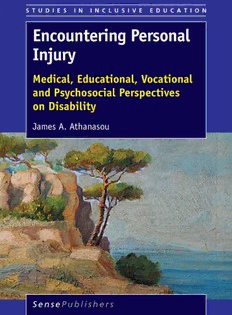
Encountering Personal Injury Medical, Educational, Vocational and Psychosocial Perspectives on Disability PDF
Preview Encountering Personal Injury Medical, Educational, Vocational and Psychosocial Perspectives on Disability
Encountering Personal Injury STUDIES IN INCLUSIVE EDUCATION Volume 31 Series Editor Roger Slee, University of South Australia, Australia Editorial Board Mel Ainscow, University of Manchester, UK Felicity Armstrong, Institute of Education, University of London, UK Len Barton, Institute of Education, University of London, UK Suzanne Carrington, Queensland University of Technology, Australia Joanne Deppeler, Monash University, Australia Linda Graham, University of Sydney, Australia Levan Lim, National Institute of Education, Singapore Missy Morton, University of Canterbury, New Zealand Scope This series addresses the many different forms of exclusion that occur in schooling across a range of international contexts and considers strategies for increasing the inclusion and success of all students. In many school jurisdictions the most reliable predictors of educational failure include poverty, Aboriginality and disability. Traditionally schools have not been pressed to deal with exclusion and failure. Failing students were blamed for their lack of attainment and were either placed in segregated educational settings or encouraged to leave and enter the unskilled labour market. The crisis in the labor market and the call by parents for the inclusion of their children in their neighborhood school has made visible the failure of schools to include all children. Drawing from a range of researchers and educators from around the world, Studies in Inclusive Education will demonstrate the ways in which schools contribute to the failure of different student identities on the basis of gender, race, language, sexuality, disability, socio-economic status and geographic isolation. This series differs from existing work in inclusive education by expanding the focus from a narrow consideration of what has been traditionally referred to as special educational needs to understand school failure and exclusion in all its forms. Moreover, the series will consider exclusion and inclusion across all sectors of education: early years, elementary and secondary schooling, and higher education. Encountering Personal Injury Medical, Educational, Vocational and Psychosocial Perspectives on Disability James A. Athanasou The University of Sydney, Australia A C.I.P. record for this book is available from the Library of Congress. ISBN: 978-94-6300-655-2 (paperback) ISBN: 978-94-6300-656-9 (hardback) ISBN: 978-94-6300-657-6 (e-book) Published by: Sense Publishers, P.O. Box 21858, 3001 AW Rotterdam, The Netherlands https://www.sensepublishers.com/ All chapters in this book have undergone peer review. Cover image: Landscape with Sea, by Georgios Roilos, oil on canvas (Private collection) [Public domain], via Wikimedia Commons Printed on acid-free paper All Rights Reserved © 2016 Sense Publishers No part of this work may be reproduced, stored in a retrieval system, or transmitted in any form or by any means, electronic, mechanical, photocopying, microfilming, recording or otherwise, without written permission from the Publisher, with the exception of any material supplied specifically for the purpose of being entered and executed on a computer system, for exclusive use by the purchaser of the work. This book is dedicated to the Estia Foundation for people with disabilities TABLE OF CONTENTS Preface ix Chapter 1: Personal Injury 1 Chapter 2: Disability 7 Chapter 3: Burn Injury 13 Chapter 4: Musculoskeletal Injury 21 Chapter 5: Whiplash Associated Disorder 41 Chapter 6: Back Pain 53 Chapter 7: Chronic Pain 69 Chapter 8: Psychological Disability 79 Chapter 9: Mood Disorder 91 Chapter 10: Anxiety and Stress Disorder 99 Chapter 11: Traumatic Brain Injury 117 Chapter 12: Vision Impairment 131 Chapter 13: Hearing Impairment 141 Chapter 14: Amputation 149 Chapter 15: Spinal Cord Injury 157 Chapter 16: Stroke 165 Chapter 17: Substance Abuse 171 Chapter 18: Rehabilitation and Personal Injury 181 Cases Cited in the Text 191 About the Author 193 Index 195 vii PREFACE Welcome to Encountering Personal Injury. At first glance it might seem like a topic of narrow relevance but disability in one form or another affects more than one-fifth of the population. Disabilities are extensive and have many causes. One major cause is injuries. The injuries that bring about a disability affect people at every stage of life but principally in adolescence and adulthood. This is mainly through motor vehicle accidents or workplace incidents but also through professional, public or other negligence. The effects are widespread – often there is a lifelong impact on health, education, employment, finances, family or self. One way in which we address these consequences is through the field of rehabilitation counselling. Medical, educational, vocational or psychosocial rehabilitation counselling is an expression of care for another person. It is a belief in their potential to lead a meaningful life following a personal injury. The existence of this discipline is a feature of the extent to which we value human life and an indicator of how much we are a civil society. I believe that we have a responsibility to assist as much as possible. For the rehabilitation counselling practitioner this requires some background knowledge but also awareness of the varied effect of an injury on the life of a person. This book is merely an introduction to this vast field. It is directed towards an understanding of some implications of a disability that arise from a personal injury. Consequently, it does not deal with chronic illness, congenital or developmental disabilities. It serves mainly as an introduction to a select number of conditions: traumatic brain injury, spinal cord injury, psychiatric impairment, substance abuse, musculoskeletal injury, amputation, burn injuries, chronic pain, stroke, vision impairment or hearing impairment. ix
